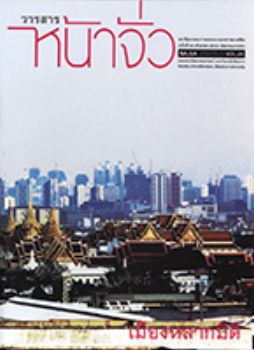การขยายตัวของชุมชนบริเวณชานเมืองกับความยั่งยืนทางสังคม
Keywords:
การพัฒนาที่ยั่งยืนทางสังคม, ชุมชนที่ยั่งยืน, บริเวณชานเมืองกรุงเทพมหานคร, Social Sustainability, Sustainability of Communities, Metropolitan FringeAbstract
ประเด็นปัญหาการขยายตัวอย่างรวดเร็วบริเวณชานเมือง ได้รับความสนใจอย่างมากจากนักวิชาการและนักวิจัยทางด้านผังเมือง ขณะที่บริเวณชานเมืองเป็นที่นิยมในการอยู่อาศัยของประชากรส่วนใหญ่ ลักษณะของการพัฒนาชานเมืองกลับตรงข้ามกับลักษณะของการพัฒนาอย่างยั่งยืนอยู่มากในเชิงการใช้ที่ดินและพลังงาน และเนื่องจากงานวิจัยที่ผ่านๆ มา ส่วนใหญ่มุ่งเน้น ความสนใจในมิติทางสิ่งแวดล้อมและเศรษฐกิจของการพัฒนาอย่างยั่งยืน ดังนั้น งานวิจัยครั้งนี้มีวัตถุประสงค์เพื่อศึกษาความยั่งยืนทางสังคมของชุมชนในพื้นที่บริเวณชานเมืองกรุงเทพมหานคร
งานวิจัยนี้มีลักษณะงานวิจัยเชิงปริมาณ เพื่อการศึกษาเปรียบเทียบตัวบ่งชี้สำคัญๆ ที่มีผลต่อการพัฒนาที่ยั่งยืนทางสังคมในชุมชนต่างๆ ในบริเวณชานเมือง โดยใช้แบบสอบถามศึกษาความคิดเห็นของครัวเรือนที่อาศัยอยู่ในชุมชนชานเมือง ชุมชนหมู่บ้านจัดสรร และเคหะชุมชนจำนวน 405 ครัวเรือนใน 6 เขตชานเมืองของกรุงเทพมหานคร เครื่องมืออื่นที่ใช้เก็บรวบรวมข้อมูล ได้แก่ การสำรวจและสังเกต การบันทึกภาพถ่าย และการสัมภาษณ์แบบไม่มีโครงสร้าง
ผลจากการศึกษาบ่งชี้แนวโน้มการเพิ่มความหนาแน่นประชากรในบริเวณชานเมือง อย่างต่อเนื่องและการขยายตัวของสิ่งปลูกสร้างไปอย่างกว้างขวาง สำหรับในเชิงสังคม ผู้อยู่อาศัยในชุมชนทั้ง 3 ประเภทในบริเวณชานเมืองกรุงเทพมหานคร มีความคิดเห็นต่อตัวบ่งชี้ของการพัฒนาที่ยั่งยืนทางสังคมของชุมชนโดยรวมไม่แตกต่างกัน โดยชุมชนทุกประเภทมีการพัฒนาที่ยั่งยืนทางสังคมในระดับชุมชนในเกือบทุกด้านอยู่ในระดับมากถึงปานกลาง ยกเว้นด้านการปะทะสัมพันธ์ทางสังคม ทั้งนี้ ผู้อยู่อาศัยในชุมชนที่ทำการศึกษาเป็นผูมี้รายได้ปานกลาง-ต่ำ และรายได้น้อย มีการตั้งบ้านเรือนอยู่ในบริเวณพื้นที่ที่ลุ่มตํ่า โดยหลายชุมชนอยู่ในตำแหน่งที่มีการเข้าถึงไม่ดี หรือเป็นมุมอับทางด้านการคมนาคมขนส่ง
ผลจากการศึกษาสามารถนำเสนอแนวทางในการส่งเสริมการพัฒนาที่ยั่งยืนทางสังคม ในระดับชุมชน โดยในเชิงนโยบายและมาตรการทางด้านผังเมือง ควรสนับสนุนการรวมกลุ่มของการตั้งถิ่นฐานแบบความหนาแน่นสูงมากขึ้น จะทำให้สะดวกในการเข้าถึงระบบขนส่งมวลชนและบริการสาธารณะต่างๆ และคุ้มค่าในการลงทุนของภาครัฐมากกว่าการพัฒนาแบบกระจัดกระจาย ไร้ทิศทาง ควบคู่ไปกับมาตรการในการอนุรักษ์พื้นที่เกษตรกรรมและประมงและพื้นที่รับนํ้าบริเวณชานเมือง สำหรับในเชิงสังคม ควรมีนโยบายปรับปรุง บำรุงรักษาและออกแบบองค์ประกอบทางกายภาพของชุมชน เพื่อสนับสนุนการเดินเท้าและการพบปะกันภายในชุมชน การสนับสนุนงบประมาณของรัฐในการจัดกิจกรรมเป็นกลุ่มภายในชุมชน และการพัฒนาทุนทางสังคมที่มีอยู่ของไทย ก็จะเป็นการช่วยเชื่อมโยงคนในสังคมไว้ด้วยกัน บรรลุเป้าหมายของการพัฒนาชุมชนที่ยั่งยืนและการเสริมสร้างคุณภาพชีวิตต่อไป
Urban Expansion on the Metropolitan Fringe and Sustainable Communities
Assistance Professor Salinee Sukolratanametee, Ph.D.
Department of Architecture and Planning, Faculty of Architecture, King Mongkut’s Institute of Technology Ladkrabang
Sineenart Sukolratanametee, Ph.D.
Department of Urban Design and Planning, Faculty of Architecture, Silpakorn University
The rapid expansion of settlements on the metropolitan fringe is of concern to many urban scholars and researchers. Although the metropolitan fringe is socially popular for settlements, its development pattern is mainly contrast to sustainability characteristics especially in terms of use of land and energy. Most previous research on sustainability has been dominated by environmental and economic concerns; the objective of this research is to contribute to a better understanding of the social dimension of sustainable development particularly of community groups on the urban fringe of Bangkok.
The study is a quantitative investigation, comparing eight composite indicators of social dimensions which are important in helping to sustain local communities. Questionnaires were conducted in 405 households of 3 types of communities within 6 districts of the outer areas of the Bangkok Metropolitan Area. Other instruments for data collection include field survey and observation, photograph records and unstructured interview.
The survey results show the increasing trend of population density and the excessive construction in the outer and low-density areas. It was found that these 3 types of communities score well and fairly on almost all composite indicators of social sustainability, except social interaction. There is no marked difference for overall scores from these communities. In addition, the residents in the case study areas are characterized as low to middle-income households, residing their houses on the low-lying lands. Many communities are situated on the relatively poor location, having inconvenient access to main roads and transportation network.
Lastly, it is suggested that policy making and planning strategies should be formulated to promote agglomeration of settlements with higher density of urban development in order to make access to services and facilities more convenient and
economically viable than un-controlled patterns of sprawl in the outer areas. Simultaneously, government intervention is needed to protect prime agricultural land and greenbelt areas which can be served as catchment area in the wet season. Policies conducive to social sustainability should seek to encourage walkable neighborhoods and social interactions in the communities via design and neighborhood upkeep, provide budget to support local activities and group participation, and promote the development of existing social capital. These will help holding society together and achieving sustainable community goals and quality of life as well.





